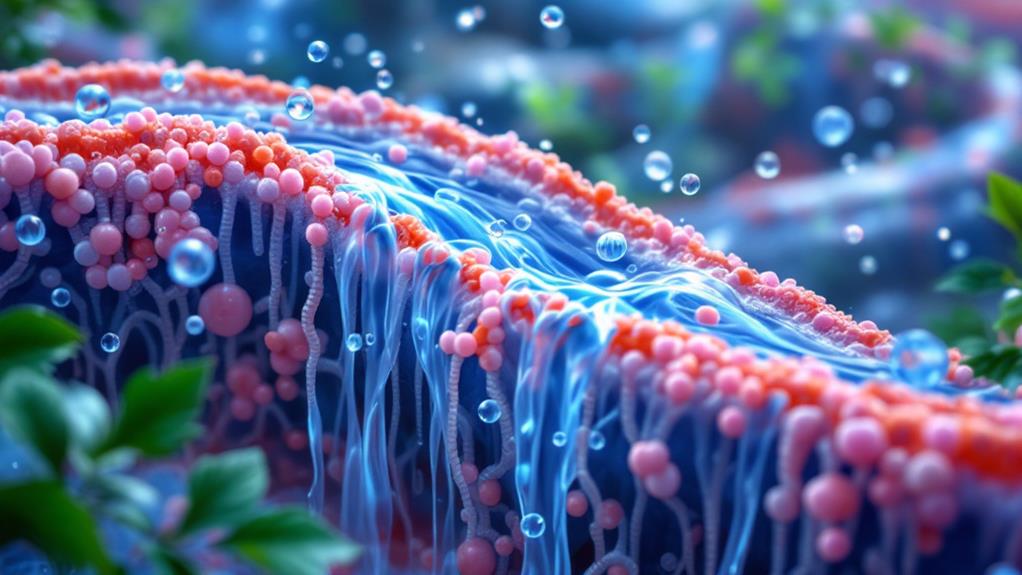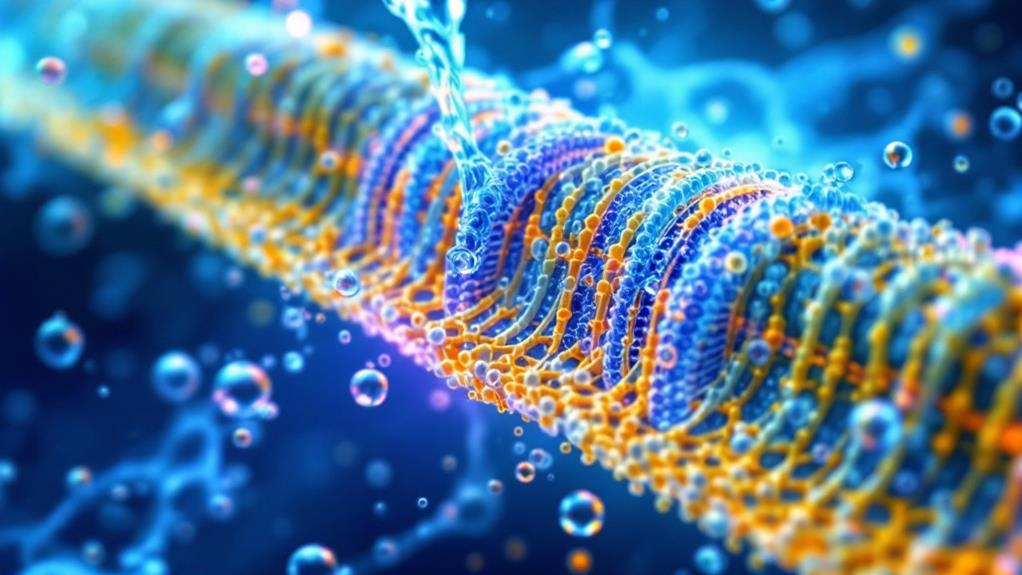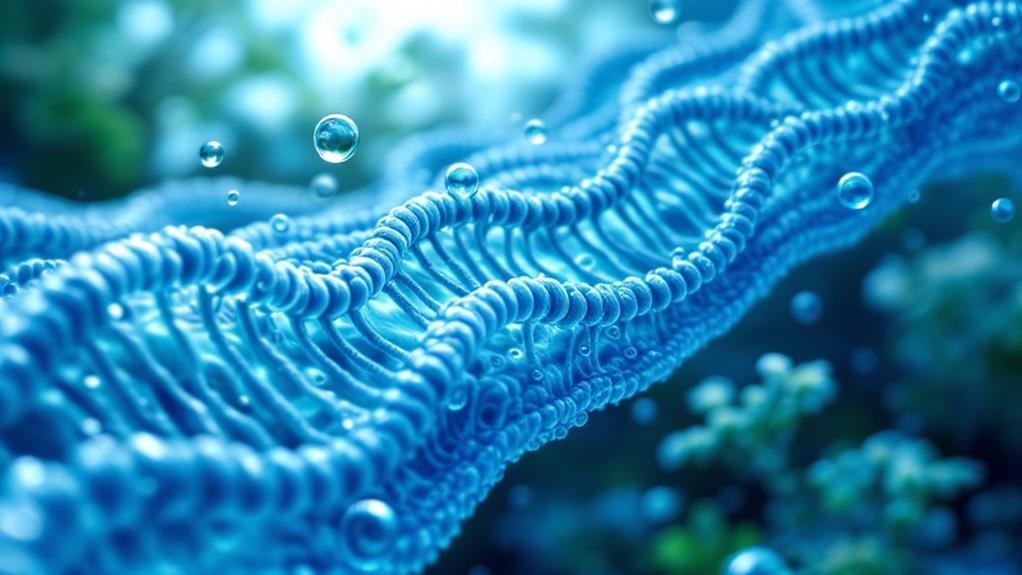The Amazing Origins of Aquaporin Water Filters: Biomimicry in Action

You'll be amazed to learn that nature's own water filtration system, found in the cells of all living organisms, has inspired a revolutionary technology in water purification. Aquaporins, specialized proteins that act as molecular water filters, can transport billions of water molecules per second while maintaining selective permeability. Scientists have harnessed this biological wonder to create highly efficient synthetic membranes for water treatment. These aquaporin-based filters can remove up to 99% of contaminants, including bacteria and viruses, with astounding energy efficiency. The potential applications range from drinking water purification to industrial processes. Plunge deeper to uncover the fascinating expedition from cellular biology to state-of-the-art water treatment solutions.
Nature's Molecular Water Filters
The marvel of aquaporins lies in their ability to act as nature's molecular water filters. These extraordinary proteins, found in the cell membranes of living organisms, facilitate efficient water transport while maintaining selective membrane permeability. You'll find aquaporins in everything from bacteria to plants and animals, including humans.
Imagine a microscopic gateway that allows water molecules to pass through at incredible speeds while blocking larger molecules and ions. That's exactly what aquaporins do. They're so efficient that they can transport billions of water molecules per second, making them nature's perfect solution for cellular hydration and fluid balance.
What's truly fascinating is how aquaporins achieve this selective filtration. Their structure features a narrow channel with specific amino acid arrangements that create a precise electrostatic environment. This setup allows water molecules to flow through rapidly but prevents other substances from passing. It's a testament to nature's ingenuity in solving complex problems.
Discovery of Aquaporins
Despite their essential role in cellular function, aquaporins remained hidden from scientific understanding for decades. It wasn't until the late 1980s that scientists began to unravel the mystery of these remarkable water transport mechanisms. The discovery of aquaporins revolutionized our understanding of how cells regulate water flow and opened up new possibilities in protein engineering techniques.
The journey to discover aquaporins involved several key steps:
- Observing unexplained rapid water movement across cell membranes
- Hypothesizing the existence of specialized water channels
- Isolating and identifying the first aquaporin protein (AQP1)
- Confirming the function of aquaporins through various experiments
You might wonder why it took so long to detect these indispensable proteins. The answer lies in their small size and the limitations of earlier scientific tools. As technology advanced, researchers were able to employ more sophisticated methods to study cellular structures. This breakthrough has since led to numerous applications in fields such as medicine, agriculture, and water purification. You'll find that aquaporins continue to inspire innovations in biomimicry, as scientists seek to harness their incredible efficiency for human benefit.
Biomimicry in Water Purification

By utilizing nature's ingenious design, scientists have revolutionized water purification through aquaporin-inspired technology. You'll find that this biomimetic approach has led to significant advancements in membrane design and energy efficiency.
Aquaporin-based filters mimic the natural water channels found in cell membranes, allowing water molecules to pass through while blocking contaminants. This selective permeability is achieved by carefully engineering synthetic membranes that incorporate aquaporin proteins or their synthetic analogs. The result is a highly efficient filtration system that requires less energy than conventional methods.
You'll be amazed to learn that these biomimetic membranes can remove up to 99% of contaminants, including bacteria, viruses, and dissolved solids. They're also capable of desalinating seawater with remarkable efficiency. The energy savings are substantial, as these filters operate at lower pressures than traditional reverse osmosis systems.
As you investigate this technology, you'll uncover that it's not just limited to drinking water purification. Aquaporin-inspired filters are finding applications in wastewater treatment, industrial processes, and even space exploration. By utilizing nature's time-tested solutions, we're forging a path towards a more sustainable and water-secure future.
Structure of Aquaporin Proteins
Understanding the structure of aquaporin proteins is essential to grasping how these exceptional water filters work. These crucial proteins form channels in cell membranes, allowing water molecules to pass through while blocking larger particles and ions. The molecular structure of aquaporins is highly specialized, with a unique protein conformation that enables their selective permeability.
When you examine aquaporin proteins closely, you'll notice four key structural features:
- Hourglass shape: The protein forms a narrow channel that widens at both ends, resembling an hourglass.
- Selectivity filter: A constriction point in the channel contains specific amino acids that only allow water molecules to pass through.
- Charged residues: Strategically placed charged amino acids help repel unwanted ions and other particles.
- Hydrophobic interior: The channel's inner surface is water-repelling, which paradoxically facilitates rapid water movement.
These structural elements work together to create a highly efficient water filtration system at the molecular level. By understanding aquaporins' intricate design, scientists can develop biomimetic filters that mimic nature's ingenious solution to water purification, potentially revolutionizing our approach to clean water access worldwide.
Engineered Aquaporin Membranes

Building on our knowledge of aquaporin structures, scientists have made considerable advances in developing engineered aquaporin membranes. These artificial membranes aim to mimic the incredible water filtration capabilities of natural aquaporins found in living cells. By incorporating modified aquaporin proteins into synthetic materials, researchers have created highly efficient water purification systems.
You'll find that protein engineering plays an indispensable role in this process. Scientists can alter the amino acid sequence of aquaporins to enhance their stability and functionality in artificial environments. These engineered proteins are then embedded into polymer-based membranes, creating a hybrid system that combines the selectivity of aquaporins with the durability of synthetic materials.
The membrane performance of these engineered systems is impressive. They can effectively remove contaminants like salts, bacteria, and organic compounds while allowing water molecules to pass through rapidly. This technology has potential applications in desalination, wastewater treatment, and even medical devices. As research progresses, you can expect to see further improvements in the efficiency and scalability of aquaporin-based membranes, bringing us closer to more sustainable water purification solutions.
Advantages Over Traditional Filters
Aquaporin-based water filters frequently outperform traditional filtration methods in several key areas. You'll find these innovative filters offer superior performance while addressing common issues associated with conventional systems. Their unique biomimetic design mimics nature's efficient water transport mechanisms, resulting in numerous advantages.
- Enhanced filtration: You'll get cleaner water as these filters can remove contaminants more effectively, including dissolved salts, bacteria, and even some viruses.
- Energy efficiency: Your energy costs will decrease as aquaporin filters require less pressure to operate compared to traditional reverse osmosis systems.
- Increased flow rates: You'll enjoy faster water production, as the highly selective aquaporin channels allow for quicker water passage.
- Cost effectiveness: Your long-term expenses will be reduced due to lower energy consumption and potentially longer filter lifespans.
These advantages stem from the aquaporin proteins' ability to selectively transport water molecules while blocking other substances. By employing this natural technology, you're benefiting from millions of years of evolutionary optimization, resulting in a more efficient and effective water filtration solution.
Applications in Water Treatment

Plunge into the world of aquaporin-based water treatment applications, where innovative technology is revolutionizing how we purify water. You'll find these biomimetic filters at the forefront of desalination plants, industrial wastewater treatment facilities, and even in portable water purification systems.
In desalination, aquaporin-enhanced reverse osmosis membranes are making waves. They're much more efficient than traditional membranes, allowing for greater water throughput while using less energy. This translates to lower operational costs and increased freshwater production from seawater.
For industrial wastewater treatment, aquaporin filters excel at removing contaminants like heavy metals, organic compounds, and micropollutants. You'll see them implemented in industries ranging from textiles to pharmaceuticals, where they're improving water recycling capabilities and reducing environmental impact.
In the domain of portable water purification, aquaporin technology is enabling the development of compact, lightweight systems. These are ideal for disaster relief efforts, military operations, and outdoor enthusiasts. You'll appreciate how these filters can quickly turn contaminated water into safe drinking water with minimal energy input.
As research continues, you can expect to see even more applications emerge, further optimizing water treatment efficiency across various sectors.
Environmental Impact and Sustainability
The environmental impact of aquaporin water filters is a transformative development in the quest for sustainable water treatment solutions. You'll find that these biomimetic filters contribute importantly to water conservation and sustainable development efforts worldwide.
By mimicking nature's efficient water filtration process, aquaporin filters offer several environmental benefits:
- Reduced energy consumption: They require less energy to operate compared to traditional filtration methods.
- Minimal chemical usage: The process relies on natural protein channels, eliminating the need for harsh chemicals.
- Improved water quality: Aquaporin filters remove contaminants more effectively, producing cleaner water.
- Decreased waste generation: The technology produces less waste during the filtration process.
You'll appreciate how aquaporin filters align with sustainable development goals by providing access to clean water while minimizing environmental impact. They're particularly useful in water-stressed regions, where conservation is essential. As you consider the future of water treatment, you'll see that aquaporin technology represents a notable step towards more sustainable practices, balancing human needs with environmental preservation. By adopting these innovative filters, you're contributing to a more sustainable water management approach that benefits both communities and ecosystems.
Future of Aquaporin Technology

Looking ahead, you'll find that aquaporin technology is situated for substantial advancements and widespread adoption. Researchers are exploring pioneering applications beyond water filtration, including drug delivery systems and biosensors. You'll see aquaporin membranes integrated into medical devices, enhancing their efficiency and precision.
In the water treatment sector, you can expect aquaporin-based systems to become more compact and energy-efficient. They'll be increasingly used in desalination plants, industrial wastewater treatment, and household water purifiers. As scalable manufacturing techniques improve, you'll notice these filters becoming more affordable and accessible to consumers worldwide.
You'll witness the development of hybrid membranes that combine aquaporins with other innovative materials, further enhancing their performance. These advancements will lead to even more effective contaminant removal and higher water flux rates. Additionally, you'll see aquaporin technology playing a pivotal role in space exploration, where efficient water recycling is essential.
As climate change intensifies water scarcity, you can anticipate aquaporin technology becoming a key player in global water management strategies. It'll contribute substantially to addressing water-related challenges and improving access to clean water in developing regions.



